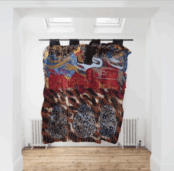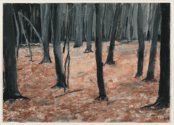Think of islands in the Pacific as presented by artists of note and the obvious touchstone is Paul Gauguin’s generous canvases of languid Tahitian beauties.
Even those, though, when seen in the flesh, present a more complex paradigm than initially seems, with a strong sense of unease dominating the more facile interpretation of ‘paradise’. It is fitting that the visual medium of art be the conduit via which we examine the full story beneath the semiotics of palm trees, pale sands and bare flesh. In an immersive exhibition open now at Übersee-Museum, Bremen, Casson Mann invite viewers to delve deeper into the Pacific blue than the typical Insta envy trap.
Extract from press materials:
“We are not drowning, we are fighting”
At Übersee-Museum, Bremen, The Blue Continent – Islands in the Pacific is a groundbreaking new exhibition designed by Casson Mann, immersing visitors in the vibrant cultures and urgent realities of Oceania.

At the heart of the exhibition stands ‘The Island’, a striking, plant-covered installation inspired by Pacific atolls, surrounded by fluid, dematerialized display structures that reflect Pacific perspectives on land and sea. This innovative design challenges conventional museum storytelling by centering Indigenous voices, in collaboration with the University of Samoa, Te Papa Museum, and Pacific communities.
Visitors will experience Oceania through interactive installations, co-created soundscapes, and personal narratives—from the ancient art of tattooing to the ongoing fight against climate change. A rallying cry from Pacific climate activists—“We are not drowning, we are fighting!”—echoes throughout, making the exhibition both a celebration and a call to action.
With themes spanning diversity, identity, colonial legacies, climate change, and natural resources, The Blue Continent is a deeply immersive, thought-provoking journey into a region whose voices and stories demand to be heard.

Casson Mann is an experiential design agency, whose mission is to deliver bespoke, innovative projects for clients from across the arts, heritage, museums and hospitality sectors. The studio has an international reputation for transforming space, content and media into beautiful, engaging experiences that communicate with and engage audiences. With expertise in exhibition, installation, museum and interior design, Casson Mann’s team of designers create environments in which visitors find themselves immersed physically and emotionally.
From March 29, 2025
Übersee Museum,
Bremen, Germany

The aim of art is to represent not the outward appearance of things, but their inward significance. – Aristotle


















